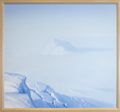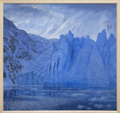Scientists hypothesize that the initial retreat of the Pleistocene-era ice sheets in North America some 14 to 20,000 years ago represents the end of the Ice Age. But from David’s perspective as an artist, he believes the Ice Age is still ending, with vast amounts of ice still locked in mountain glaciers and ice sheets.
Glaciers along the Gulf Coast of Alaska are fed by the largest ice fields in western North America. Bering Glacier and Malaspina Glacier each approximate the size of Rhode Island. Combined, the glaciers and ice fields in Alaska form one of the largest areas of glaciation in the northern hemisphere, but they are just a remnant of the Cordilleran ice sheet that once covered much of western North America.
Most of the remaining ice in North America is in Alaska’s high mountain ranges, with a smattering of glaciers in the Rocky Mountains. In the mountain ranges along the coast of Southcentral Alaska, glacier-forming snow accumulates as low as 3,000 feet during the winter due to the high amounts of precipitation along the Gulf of Alaska. The Alaska Range, which includes Denali, the highest mountain in North America, is also glaciated but less so than the coastal ranges, with snow accumulation zones year-round above 9,000 feet. Almost every glacier in Alaska is currently retreating.
Turn around and locate the paintings of Worthington Glacier on the small wall behind you. The glacier is located about 20 miles from Valdez in Prince William Sound. David first saw Worthington Glacier in 1978 on his way to catch the Alaska Marine Highway ferry. Together, these paintings illustrate how dramatic the glacial retreat is even in Thompson Pass, one of the snowiest places in Alaska with an average annual snowfall of 40 feet.
As David explains:
“Glaciers surge and retreat rapidly in geological terms, and paintings from my relatively short lifespan show significant changes over time. It might be hundreds, if not thousands, of years before the Ice Age is truly ended, but I feel very lucky to live in this time when I can still experience and paint icy landscapes.”
Please proceed to audio tour location 3.







